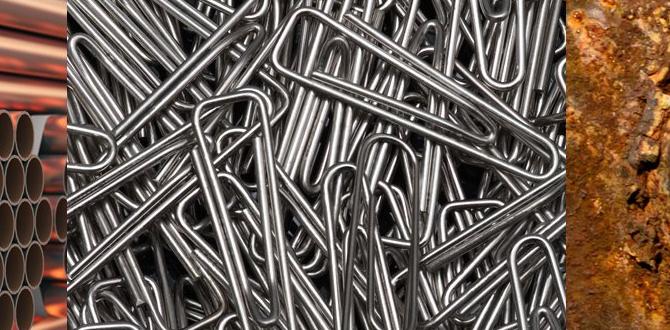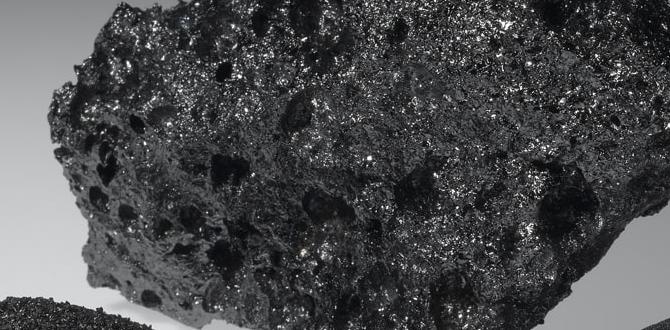Tialn Ball Nose End Mill 35 Degree: The Key to Flawless Polycarbonate Machining
For smooth, chip-free cuts and perfect finishes on polycarbonate, a TiAlN Ball Nose End Mill with a 35-degree helix angle is your go-to tool. It excels at preventing melting and sticking, ensuring clean helical interpolation and intricate designs without the frustration of material deformation. This guide makes it simple to understand why this specific end mill is essential for your polycarbonate projects.
Hey makers, Daniel Bates here from Lathe Hub! Working with plastics, especially polycarbonate, on a milling machine can be a bit tricky. It’s a fantastic material – strong, clear, and impact-resistant – but it can also be prone to melting and gumming up your tools if you’re not careful. This can lead to rough edges, wasted material, and a lot of frustration. But don’t worry, there’s a specific tool that makes a huge difference: the TiAlN ball nose end mill with a 35-degree helix angle. It’s like a magic wand for polycarbonate, helping you achieve clean, precise cuts every single time. Let’s dive in and see why this tool is so special and how it can elevate your projects.
Why a 35-Degree Helix Angle Ball Nose End Mill for Polycarbonate?
When you look at end mills, you’ll notice different features. For polycarbonate, two main things matter: the shape of the tip and the angle of the flutes (the spiral grooves). A ball nose end mill has a rounded tip, which is perfect for creating smooth, curved surfaces and for operations like pocketing without sharp corners. The real hero for polycarbonate, though, is the 35-degree helix angle. Most standard end mills have a 30-degree helix, but that extra 5 degrees makes a significant difference.
Here’s why that 35-degree angle is so crucial for polycarbonate:
- Reduces Heat Buildup: Polycarbonate melts easily. A steeper helix angle (like 35 degrees) means that the cutting edge engages the material more gradually. This shearing action produces smaller chips and, importantly, less friction. Less friction means less heat, which is the main culprit behind melting and material sticking to the tool.
- Improved Chip Evacuation: Those smaller chips are ejected more effectively from the cutting area. Good chip evacuation is vital because it prevents chips from re-cutting, which adds to heat and can ruin your finish. Better chip flow means a cleaner cut.
- Smoother Surface Finish: The gentle engagement and efficient chip removal result in a dramatically smoother surface finish on the polycarbonate. You’ll get those clean, shiny edges you want without burrs or melted blobs.
- Reduced Tool Wear: By minimizing heat and preventing material buildup, the tool lasts longer. This is good for your wallet and your workflow!
What is TiAlN Coating and Why It Matters
You’ll often see these end mills described as “TiAlN” coated. This stands for Titanium Aluminum Nitride. It’s a super-hard, wear-resistant coating applied to the surface of the end mill. Think of it as a protective armor for your cutting tool.
Here’s why TiAlN coating is a big deal for machining polycarbonate:
- Increased Hardness: TiAlN adds incredible toughness and hardness to the end mill. This allows it to maintain its sharp edge for longer, even when cutting tougher materials or at higher speeds.
- High-Temperature Resistance: This is where TiAlN really shines, especially with plastics. It can withstand much higher temperatures before degrading or losing its hardness. This directly combats the heat generated when machining polycarbonate.
- Reduced Friction and Adhesion: The smooth surface of the TiAlN coating helps to reduce friction between the tool and the workpiece. This further minimizes the tendency for polycarbonate to melt and stick to the end mill, often referred to as “built-up edge” (BUE).
- Extended Tool Life: By protecting the cutting edge from wear, heat, and material adhesion, TiAlN coating significantly extends the lifespan of your end mill. This means you’ll be replacing tools less often.
TiAlN vs. Other Coatings for Polycarbonate
While TiAlN is fantastic, it’s good to know what else is out there and why TiAlN is usually preferred for polycarbonate. You might see coatings like:
- Uncoated: These are the most basic and will likely struggle with polycarbonate due to rapid heat buildup and material adhesion.
- TiN (Titanium Nitride): A common and good all-rounder, but it doesn’t offer the same high-temperature resistance as TiAlN. It’s better for lower-heat applications.
- TiCN (Titanium Carbonitride): Offers good abrasion resistance but is also not ideal for high-temperature plastic machining.
- ZrN (Zirconium Nitride): Sometimes used for plastics, as it’s slicker than TiN. However, TiAlN generally provides a better balance of hardness and heat resistance for polycarbonate.
For polycarbonate, the combination of the 35-degree helix angle and the heat-resistant, low-friction properties of a TiAlN coating makes it the standout choice. It’s designed to overcome the specific challenges this material presents.
Key Features to Look For in Your End Mill
When you’re shopping for your TiAlN 35-degree ball nose end mill for polycarbonate, keep an eye out for these specifications:
- Material: Carbide is the standard for good reason. It’s hard, rigid, and can handle the cutting forces involved.
- Number of Flutes: For plastics like polycarbonate, two-flute end mills are often recommended. Fewer flutes mean more space for chips to escape, which is crucial for preventing melting. Some specialized plastic-cutting end mills might have even fewer flutes or unique flute designs. However, a two-flute TiAlN 35-degree ball nose is a great starting point.
- Coating: As discussed, TiAlN is your best bet.
- Helix Angle: Specifically, look for 35 degrees.
- Ball Nose Radius: This depends on your application. Common sizes include 0.5mm, 1mm, 2mm, 3mm, up to larger sizes. Choose one that matches the smallest radius you need in your design.
- Shank Diameter: This is the part that fits into your milling machine’s collet or holder. Ensure it matches your machine’s capabilities.
- Cutting Diameter: The overall diameter of the end mill.
| Feature | Why It’s Important for Polycarbonate | Recommended Specification |
|---|---|---|
| Material | Needs to be hard and rigid to cut plastic cleanly without deflecting. | Carbide |
| Flute Count | More flute space means better chip evacuation, reducing heat and melting. | 2-Flute (sometimes 1- or 3 for specialized jobs) |
| Coating | Resists heat and prevents plastic from sticking to the tool. | TiAlN (Titanium Aluminum Nitride) |
| Helix Angle | Affects chip formation and heat generation. A steeper angle shears material more cleanly and reduces friction. | 35 Degrees (preferred over 30) |
| Tip Style | Ideal for smooth, contoured surfaces and pocketing without sharp internal corners. | Ball Nose |
Getting Started with Your Polycarbonate Machining Setup
Now that you know why this end mill is the right choice, let’s talk about how to use it effectively. It’s all about setting up your machine and your cutting parameters correctly.
Your Milling Machine Setup
Ensure your milling machine is in good working order. A rigid machine is key to clean cuts. Make sure:
- Spindle is Clean and Tight: No wobbles!
- Carriage is Smooth: No binding or excessive play.
- Collet or Tool Holder is Secure: A well-fitting collet ensures the end mill runs true. A worn collet can cause runout, leading to poor finish and tool chatter.
Workholding Polycarbonate Safely
Properly securing your polycarbonate is vital. You don’t want it moving during the cut. Soft jaws are often recommended for milling clear plastics to avoid marring the surface. If you’re using standard metal vises, use thin, clean plastic or wood shims between the vise jaws and the polycarbonate. Clamp it firmly but don’t overtighten, which could crack or deform the material. For larger pieces, consider using clamps that distribute pressure evenly.
Cutting Parameters for Polycarbonate
This is where the magic happens! Getting the feed rate, spindle speed, and depth of cut right will prevent melting. These are starting points, and you might need to adjust based on your specific machine, the exact type of polycarbonate, and the end mill you’re using. Always start conservatively and increase if your results are good.
Recommended Starting Points
Here are some typical parameters. It’s always a good idea to consult the end mill manufacturer’s recommendations if available. For polycarbonate, a good rule of thumb is to keep cutting speeds relatively low to moderate and focus on a high feed rate to ensure chips are cleared effectively.
Note: SFM = Surface Feet per Minute. RPM = Revolutions Per Minute.
To calculate RPM, use: RPM = (SFM 3.82) / Diameter (inches)
Or for metric: RPM = (V 1000) / (pi * D) where V is cutting speed in m/min and D is diameter in mm.
You can find reliable online calculators for SFM to RPM conversion if you’re unsure. Always ensure your units are consistent!
| Parameter | Starting Value (for a typical 1/4″ or 6mm end mill) | Explanation |
|---|---|---|
| Spindle Speed (RPM) | 2,000 – 5,000 RPM | Lower speeds help manage heat. A TiAlN coating handles higher speeds better than uncoated, but start conservatively. |
| Feed Rate (IPM or mm/min) | 15 – 40 IPM (380 – 1000 mm/min) | This is crucial! A faster feed rate takes a good chip and moves the tool quickly, reducing heat buildup per engagement. Too slow, and it melts. |
| Depth of Cut (DOC) | 0.010″ – 0.050″ (0.25mm – 1.27mm) | Keep cuts shallow for high-gloss finishes and to minimize stress on the material and tool. For roughing, you might go slightly deeper, but always prioritize chip evacuation. |
| Stepover (Radial Width of Cut) | 25% – 50% of End Mill Diameter | This affects the surface finish in pocketing operations. A smaller stepover yields a smoother surface but takes longer. |
Coolant or Lubrication for Polycarbonate?
This is often debated for plastics. For polycarbonate, the general consensus is to avoid liquid coolants. Why?
- Melting vs. Cooling: While it might seem counterintuitive, flooding polycarbonate with liquid can sometimes lead to rapid cooling and thermal shock, causing it to crack or become brittle.
- Chip Evacuation Issues: Some coolants can mix with plastic chips and create a sticky sludge inside the flutes, exacerbating the melting problem.
- Preferred Method: Air Blast! The best approach is often a strong blast of compressed air directed at the cutting zone. This cools the cutting edge and blows away chips effectively without causing thermal shock or creating a mess.
If you must use a lubricant, a very light mist of a plastic-specific lubricant likeisopropyl alcohol (IPA) or a specialized plastic cutting fluid can be used sparingly, but always prioritize air blast if possible. Always test any fluid on a scrap piece first.
Strategies for Complex Cuts Like Helical Interpolation
This is precisely where a 35-degree TiAlN ball nose end mill for polycarbonate shines. Helical interpolation is a technique where the end mill moves in a circular path while simultaneously plunging into the material. It’s great for creating smooth-walled holes or pockets, especially when the final diameter needs to be larger than the end mill itself.
Here’s how to tackle it:
- Start Slightly Smaller: Program your helix to start at a diameter that is slightly smaller than the final desired diameter. This gives the end mill a little “room” before it fully engages the wall.
- Appropriate Feed Rate for Helix: The feed rate for the circular motion (the “feed per tooth” in the XY plane) is critical. It needs to be fast enough to clear chips effectively but not so fast that it overloads the tool. The tangential feed rate of the helix is what you’re controlling.
- Controlled Plunge Rate: The downward plunge rate (Z-axis) needs to be slower than your XY feed to manage heat.
- Use Your 35-Degree Ball Nose: The ball nose shape is naturally suited for this. The 35-degree helix angle provides the cutting geometry that’s least likely to cause melting and sticking during this continuous cutting motion.
- Monitor and Adjust: Listen to your machine. If you hear chirping or squealing, the feed rate might be too slow, or you’re cutting too deep. If you see smoke or melting, slow down the RPM or slightly increase the feed rate (carefully!).
For more on the technical aspects of calculating these parameters, the National Institute of Standards and Technology (NIST) provides valuable resources and algorithms for machining data, which can be a great starting point for understanding the physics involved. You can often find their publications through sites like NIST.gov.
Troubleshooting Common Issues
Even with the right tool, you might run into snags. Here’s how to fix






